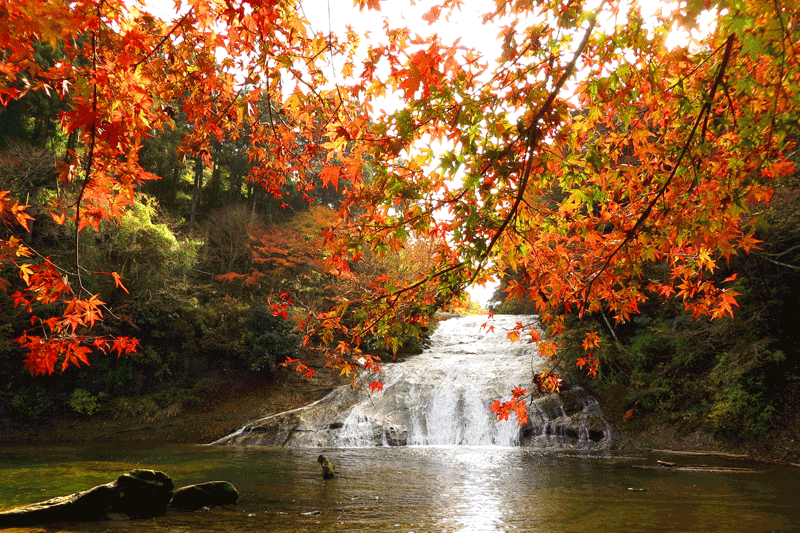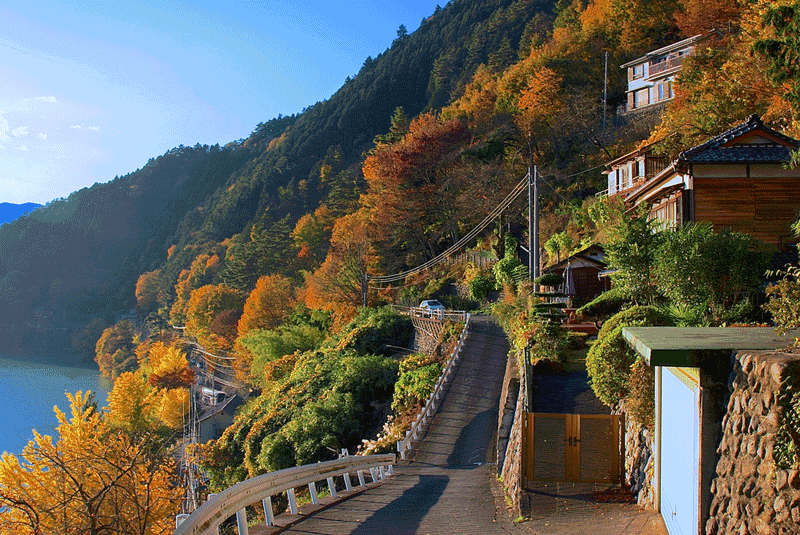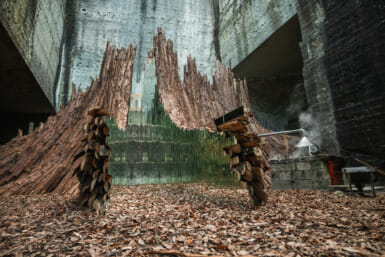Now that we have, with some resistance, put away our summer yukata, it is time to lap up autumn’s beauty before the sparkling winter holidays arrive. Break up the monotony of those work weeks and take advantage of these hot spots we’ve pinned during peak koyo (changing foliage) times for each area.
Ibaraki Falls
Ibaraki lies a bit north of the neon epicenter: a Shinkansen from Ueno Station will get you there in just under thirty minutes for ¥5,000. The stunning Fukuroda Falls are a must for this autumn’s to-visit list. Situated in Ibaraki’s claim to fame, Hananuki Valley, the shape-shifting falls cascade through a valley of low hanging, brightly hued foliage throughout autumn. The boardwalks and criss-crossing bridges provide ample viewing and alternating perspectives of the falls and treetops. Some evenings, the park staff illuminates the falls in brilliant colors to create images and rainbow effects.
A lesser-known koyo viewing spot, Hanazono Valley is home to lower-set, wide waterfalls and spectacular fall foliage. One can also find a large number of quiet temples and shrines in the area, adorned in reds and browns, blending into the seasonal color palette.
Need a break? Nearby these falls is the famed Daigo community that harbors several luxury hot springs. The Omoide Roman-kan onsen (http://bit.ly/TWRomankan) is a monolithic ryokan that offers beautiful indoor (private) and outdoor (communal) hot springs to relax in. The views of the river and adjoining park make it a worthwhile visit.
If you’re looking to stay longer, the enormous Tsukuba Grand Hotel (http://bit.ly/TWTsukuba) offers pleasant accommodations and an outdoor onsen (rotemburo) with particularly lovely views. The rotemburo is open all hours, so guests can marvel at the glittering cities at night, or watch the fog roll in during sunrise, high up the mountain slope.
Chiba Koyo
Tokyo’s neighbor Chiba has plenty to offer the traveler than Disneyland churros and the Narita Airport, and fall is a perfect time to embrace all of the region’s treasures.
For more adventurous types, Lake Kameyama is the ultimate destination. With boating, canoeing, and hiking options in the vicinity, the vast lakebed is a dream for the athletically active or the active photographer. Quaint bridges, solitary temple arches, and the occasional cavern provide much to do for families and independent explorers.
And the koyo? About twenty minutes from Otaki Station, visitors clamor to see stunning panoramas of foliage in Tsutsumori Momiji Valley (literally: Valley of Fall-Colored Forests). The region includes old Otaki town, a “natural village,” the 100m long Awamata Falls and picturesque footbridges, Momiji Road (a 10km driving course through rows and rows of maple trees), and plays home to the Yoro Valley Fall Leaves Festival on November 23.
When it comes to accommodation, we have two suggestions. First is Taiyo no Sato Bettei Umi to Mori (http://bit.ly/TWTaiyo), an upscale luxury ryokan with private onsen options. Between the unobstructed sunrise views over the ocean, fusion Western and Japanese-styled rooms, and gourmet lobster dinners, it’s no surprise the rooms are constantly in high demand.
A second option is the more affordable, but just as beautiful, Kamogawa Hotel (http://bit.ly/TWKamogawa). It has outdoor patios in the back gardens, and gazebos with strings of lights hanging over onsen; guests will find a mini paradise off the Chiba coastline, while being not too far from the parks and fall sights.
Gateway to the Alps
Kamikochi is one of those idyllic locations that travel brochures aunt, promising breathtaking hikes and colors. The truth? The area truly lives up to those images. Surrounded by the skyline of the Japanese Alps, Kamikochi can be reached by bus from Shinjuku Station. A mere two hours from the city, and you’ll be in the heart of “virgin” forests, and roaming one of the country’s beloved national parks.
The area explodes in natural colors like reworks during late fall. With the genuine peace and quiet and the relatively small crowds, you can truly escape and connect with nature, however brief the visit. However, due to the vastness and limited transportation, it is recommended to choose a side of the park to visit and stay in.
What are the differences between them? The southern valley is home to Taisho Pond, and avid hiking fans often stay in that area for the research trails and access to Mt. Yakedake. Two spa inns, Nakanoyu (http://bit.ly/TWNakanoyu) and Sakamaki (http://bit.ly/TWSakamaki), will accommodate your every need, even helping with equipment rentals throughout the year. The northern side of Kamikochi features breathtaking Myojin Pond and Bridge, and the impressive Japanese Alps and Hotaka Mountain range begin close to here. Stay at the aptly named Kamikochi Hotel (http://bit.ly/TWKamikochi), which offers guests the option to stay in their hotel or in a private cabin – both have indoor and outdoor onsen, so the relaxation never stops.
Get Away from Tokyo – In Tokyo
Of course, it’s possible to savor the fall foliage and escape the frantic pace of Tokyo without actually going beyond the city limits. An hour trip from the city center, the Tama area offers prime koyo viewing spots, and plenty else to do there.
A short walk from Hatonosu Station on the JR Ome Line, Hatonosu (Dove’s Nest) Valley can be admired from a suspension bridge that looks out over the gorge some 40 meters below. A stunning sight any time of the year, it truly comes into its own in November, when the changing leaves turn the valley into a riot of colors.
Take the JR Ome Line to its terminus, Okutama Station, and you can stroll around the Hikawa Keikoku, a river valley that shows off its nest hues in autumn. The area can best be explored via a four-kilometer walkway that goes from Okutama Station, alongside the Nippara and Tama Rivers, and past Mt. Atago.
After a bit of foliage viewing in the chilly air, a soak in an onsen is the perfect way to warm up and the Moegi no Yu onsen, which is fed by a source of alkali waters that is believed to be the oldest in all of Japan. If you’d like to make a weekend of it, the Arasawaya Ryokan offers plenty of rustic charm, delicious meals, and the opportunity to hear folktales told by traditional forest storyteller Hiroji Arasawa.
Aside from the fall foliage sights, those with an interest in traditional crafts can try their hand at indigo dyeing at Kosoen, a workshop that has been keeping this colorful tradition, which dates back well into the Edo period, going. You can browse the selection of handmade pieces, or take part in a mini-lesson and tie-dye a handkerchief or a light scarf.
Finally, for the beer lovers, there’s no missing Beer Cafe Vertere. Just a few paces away from Okutama Station, a few pints of their home- brewed beer and their rotating selection of guest taps, as well as an assortment of pub-style dishes, will have you riding the rails back home with a smile on your face.
Tama offers plenty of other intriguing and appealing attractions. Please see “The Tama Promotion Project” home page for more details: tama120.jp/english










